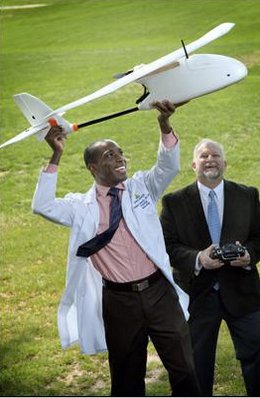Laboratory tests performed on blood samples flown for up to 40 minutes on hobby-sized drones yielded results comparable to those performed on samples that never left the ground, according to a proof-of-concept study conducted by researchers at Johns Hopkins University.
The findings suggest that unmanned aircraft systems could potentially be a safe method to transport blood samples and other fluids, Timothy K. Amukele, MD, PhD, pathologist at Johns Hopkins University School of Medicine, and colleagues wrote.
 If confirmed, this could considerably reduce the time it takes for health care workers in rural, impoverished or other remote areas to perform lab tests, results of which often are needed to make accurate diagnoses and determine treatment options.
If confirmed, this could considerably reduce the time it takes for health care workers in rural, impoverished or other remote areas to perform lab tests, results of which often are needed to make accurate diagnoses and determine treatment options.
Biological samples are “very sensitive and fragile” and often cannot be transported via pneumatic tube systems used in many hospitals, Amukele — who directs a laboratory collaboration between Johns Hopkins and Uganda’s Makerere University — said in a press release.
Consequently, Amukele and colleagues were unsure whether the sudden acceleration of drones when they are launched, as well as the force associated with landing, would have an effect on transported blood samples.
“Such movements could have destroyed blood cells or prompted blood to coagulate, and I thought all kinds of blood tests might be affected, but our study shows they were not,” Amukele said.
For their study, Amukele and colleagues obtained three paired blood samples from 56 adult volunteers at The Johns Hopkins Hospital, for a total of 336 samples. Researchers used one paired sample for chemistry testing, another for hematology testing and another for coagulation testing.
The investigators drove all samples to a flight field approximately 1 hour from the hospital. They held half (n = 168) of the samples stationary. They placed the remaining samples — packaged to prevent leaks — on hand-launched, fixed-wing drones, which were flown for durations ranging from 6 minutes to 38 minutes.
Per FAA regulations, the drones flew in an unpopulated area, never exceeded 100 meters (328 feet) and remained in sight of a certified pilot at all times.
Researchers then performed 33 common laboratory tests — including those for glucose, sodium and red blood cell count — on all blood samples. Results showed no significant differences between samples flown on drones and those that remained on land.
Overall concordance was 97%, and the length of flight did not impact results.
However, Amukele and colleagues did observe differences in results from a test for total carbon dioxide, also known as the bicarbonate test. Although researchers are not certain why this happened, they indicated it might be due to how long some of the samples sat — as long as 8 hours — before undergoing testing.
“This study’s most significant limitation is that the volunteers were mostly healthy individuals, and so their results were in the relatively narrow normal range rather than spread across the full assay range for each test,” the researchers wrote. “Thus, we do not know the impact of [drone] transport on results that are outside of the normal reference range. Subsequent experiments will be required to flesh out changes across the full reporting range of each test type. Nevertheless, this paper is an important first step in determining if laboratory tests for the most common analytes used in health care are reliable when those samples are transported by [drones].”
The likely next step is a pilot study in a location in Africa where health care clinics are 60 miles or more away from labs, Amukele said.
“A drone could go 100 kilometers in 40 minutes,” Amukele said in the press release. “They’re less expensive than motorcycles and are not subject to traffic delays, and the technology already exists for the drone to be programmed to ‘home’ to certain GPS coordinates, like a carrier pigeon.” – by Jen Southall
Source: Healio
